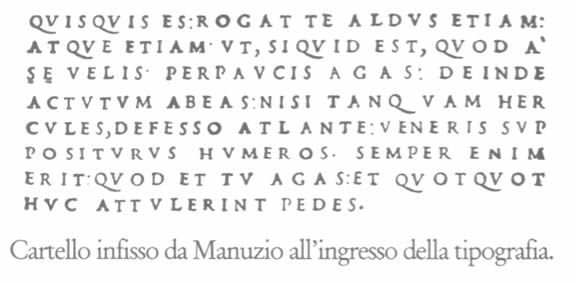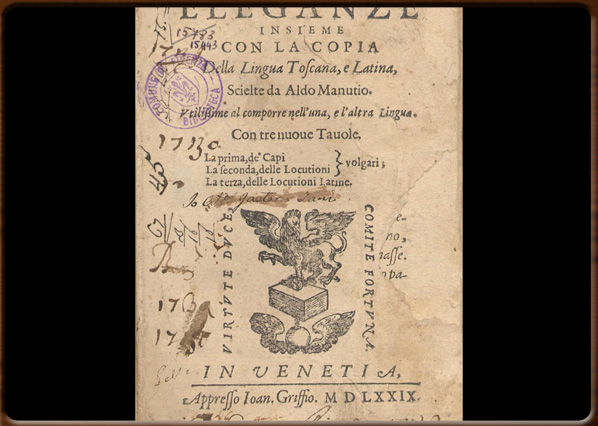In the 15th Century, seven centuries after its foundation, the Venetian Republic reached the height of its expansion.
No European state could or would ever again boast such a great future and such a long period of continuity. The Venetian political system, its relative stability and its accumulated wealth contributed to the birth of the greatness of Venice, making the city a benchmark and model for the whole world.
Contrary to what happened in other states, the Serenissima was particularly open to all religious philosophies, provided that none of these threatened its safety.
The first printers to arrive in Venice were German, followed by French, Flemish, Dutch, Swiss, Cretian and Istrian printers and many Italians.
In Rome, Pope Paul II had closed the Academy of Pomponio Leto on charges of conspiracy and irreligiosity. This is probably why such a large group of "reformist Humanists" fled to Venice, among them Aldo Manuzio , Marc'Antonio Sabellico and Francesco Colonna.
The freedom of the press was guaranteed and encouraged, especially since the expansion of printing had become such a good source of income in a matter of a few years . Venetian publishing not only called for collaboration, but also stimulated printers to experiment. The Senate even set down severe penalties for publishers who dared to use low-quality paper in 1537.
It is logical, therefore, to assume that authors not only saw Venice as the chance to get their works published, but also as having the facilities needed to accommodate them, plus the opportunity to discuss and compare their individual experiences.
Nearly 200 printing presses were operating in Venice towards the end of the 15th Century (1488). Output was substantial: the publisher Aldo Manuzio had produced 157 titles between the years 1494 and 1515, often with very high circulation (even more than 1000 copies – using manual printing presses). Some 447 books were printed in Venice between 1495 and 1501, about one fourth of total European production.
The Art of printing was officially recognised in Venice on September 18th, 1469 – the day the Senate recognised that Johann von Speyer (Giovanni da Spira) had introduced and developed the art in Venice. Although the Senate recognised this skill, there was still no public register.
The Mariegola of the “Arte dei Stampadori e Libreri" (printers and booksellers) was finally ratified on May 14th, 1567.
The first truly Venetian printing press was set up by Filippo di Pietro in 1472.
The “Scuola dei Stampadori e Libreri” always met at the Dominican monastery of Santi Giovanni e Paolo.
An altarpiece by Giovanni Bellini was commissioned in the second half of the Fifteenth Century to replace the wooden altar at the bottom of the right nave that had been destroyed in a fire (it is thought that this had become the altar of the “Scuola dei Libreri e Stampadori”). The Giovanni Bellini altarpiece was also destroyed in another fire on the night between the 15th and 16th of August, 1867, in the Capella del Rosario where it had been removed for renovation (completed). Fortunately we still have a copy that depicts three children intent on reading a book in the centre of the scene, under the Holy Virgin seated on her throne.
The cultural climate enjoyed by printers in Venice was that of a city ready to welcome all schools of thought and trends, filtering these and turning them into its own peculiar heritage.
A real university was never established in Venice. Numerous cultural centres existed, however, such as the circle of the Greek scholar Giovanni Lascaris and the Rialto and San Marco schools holding classes in moral philosophy and rhetoric (only open to the noblility).
Teachers at the Scuola di San Marco (founded in 1408) included Giorgio Merula, Giorgio Valla and Giorgio da Trebisonda. After its closure (March 31st, 1485, following a disastrous fire), many books and manuscripts were rescued and transferred to Ferrara where they are now stored in the Estense Library.
Classes in logic, natural philosophy and mathematics were held on the premises of the Chiesa di San Giovanni Elemosinario. In 1484 the humanist Ermolao Barbaro founded an Academy of Aristotelian philosophy at the Fondamenta San Giovanni alla Giudecca in his family’s palace.
There were important centres for intellectual discussion with splendid libraries attached to them in the monasteries of the churches of Santi Giovanni e Paolo, dei Frari, Santo Stefano, S. Francesco della Vigna, San Michele in Isola and Sant’Antonio in Castello.
Other "private" libraries in the city included that of Cardinal Bessarione with its 482 Greek manuscripts and 264 Latin manuscripts (later donated to the city of Venice in May 1468).
Other such libraries belonged to Francesco and Ermolao Barbaro, Cosimo de’ Medici in San Giorgio Maggiore, the Paolina University of Medicine and Philosophy and the Libreria di San Marco.
Thanks to the efficiency of the Venetian Stato, representatives of the cultural world were able to perceive and feed a meaning of life "without" the anguish of the time and the violence of power. Venetians almost seemed to have developed a conviction that the Serenissima had always existed and that no force could ever over upset its stability over the centuries.
This relative "social peace" allowed and encouraged artists to undertake research in all disciplines, even in those philosophical and religious areas that were often forbidden and persecuted in other nations.
In the early 16th Century, however, this "social peace" began to break up, partly due to internal tensions between families involved in the management of the state, incited by the temporal power of the Church of Rome, and partly as a result of the military defeats Venice suffered mainly in the Adriatic and the Aegean.
Conditions were therefore changing.
In the climate stimulated by the Counter-Reformation, the numerous trials of people of every class accused of an inclination to Lutheranism put a stop to the intellectuals and artists’ aspirations, research and willingness to embrace new ideas. The freedom of the press suffered a hitherto unthinkable attack.
Marin Sanudo, in his Diarii (1496 - 1533) , notes that on August 25th, 1520, the deputy patriarch demanded that the Governing Council of the Senate condemned the work of Martin Luther and should consequently prohibit its publication.
Luther had many sympathisers: his texts circulated in the city under the pseudonym of Lambertus da Nigroponte .
The first Lutheran catechism was published in 1525 by Zopino.
Venetian booksellers, as a response to what they rightly considered a form of censorship and thus a ban on their work, organized a thick network of clandestine imports of prohibited volumes. As a result of this, some booksellers were arrested and the Corporation undertook to support their wives and children.
In 1527 the volumes of Luther and his followers were burned in Campo San Giacometto a Rialto. Jewish books, including the Talmud, were also publicly burnt in St. Mark’s Square in 1533.
ALDO MANUZIO AND HIS TRADEMARKAldo Manuzio was not just a printer, but an actual publisher . An extraordinarily erudite man, he helped preserve many texts and guaranteed excellent results.
The printer’s early headquarters were in Calle del Pistor, number 2343, near Campo Sant'Agostin; he moved his operations to Calle San Paterniano near what is now Campo Manin in 1508.
Somewhat rough and ready, Aldo Manuzio hated to waste time and so hung a sign at the entrance to his printing shop to discourage time-wasters .
As a printer, he published the Hypnerotomachia Poliphili in 1499 for the publisher Leonardo Crassus in Verona (at the time the Apostolic Protonotary. He was also famed for having invented his own type, possibly with the help of the philosopher Friar Luca Pacioli and the designer Francesco Griffo of Bologna.
Manuzio’s books were held in great regard and received numerous awards throughout Europe , but suffered precisely for this reason from imitation and counterfeiting by other publishers, especially in Florence and Lyon. This led to his making repeated complaints, until he printed a solemn warning in a volume by Horace (Carmina) published in May 1501: "Iussu, mandatove Illustrissimi P (opuli) S (enatus) Q (ue) V (eneti) Nobilis. Literator. Plebeie. Impressor. Mercator: Mercenarie quisquis es. Id genus Characteres. Ne attingito..."
(With the authorisation of the Illustrious People and Senate of Venice. Erudite gentleman, member of the public, printer, merchant, mercenary or whoever you are. Do not use this form of type.)
In a volume of epigrams by Martial, published in the same year, Manuzio added this curse in block capitals: "Quisquis es qui quoquomodo huiusce excusionis ergo adversus ieris, damnatus esto et reus Ill. S.V. Ne dicas tibi non praedictum cave."
(Whoever you are and whatever way you violate the decree concerning this type, you will be found guilty before the Illustrious Senate of Venice. You cannot say you have not been warned.).
His printing house became a true literary circle. Manuzio was aware of his great responsibility: he summoned the most outstanding humanists of the time in Italy to act as correctors (not just translators and editors of drafts, but proper editors and editorial consultants).
Also his choice of paper – produced by the Fabriano papermill (the best on the market), format 32 x 42 cm – led to a surprising result. When folded in half, he got the "folio" (32 x 21 cm), in four the “quarto” (16 x 21 cm), in three the “octavo” (10.5 x 16 cm). Manuzio designed and started using the “octave” with great commercial success: in other words, he had already invented the paperback (pocket book or "encheridio") in the early 16th Century.
In May 1502 Manuzio founded an academy, the "Neacademia dei filelleni", or Aldina Academy.
He had such a great passion for the Greek language that meetings had to be held in Ancient Greek, with fines imposed for anyone speaking any other language, the proceeds to be spent on a banquet for Academy members.
He encouraged business relationships, collaboration and friendship with the best minds of the time: Poliziano, Gerolamo Donà, Erasmus von Rotterdam, Pico della Mirandola, Alberto Pio di Carpi, Pietro Bembo, Andrea Giovanni Lascaris, Fra Giovanni Giocondo, Elia del Medigo and Francesco Colonna, to name but a few.
Manuzio was a very prolific publisher: he published the full works of Aristotle, part of Plato (translated by Marsilio Ficino), the works of Aristophanes, Theocritus, Isocrates, Homer and Euripides. Among the Italian authors he published were Dante Alighieri, Petrarch, Fra Giovanni Giocondo, Pietro Bembo, Poliziano and Saint Catherine of Siena.
Thanks to his expertise, talent and skill, the Senate appointed Manuzio as the official printer of the Venetian Republic on November 14th, 1502, having been sponsored by Marin Sanudo il Giovane (1466-1536).
The decree described Manuzio as a man \n\nThis file was not retrieved by Teleport Pro, because the server reports that this file cannot be found. \n\nDo you want to open it from the server?'))window.location='http://www.venicethefuture.com/schede/uk/>
Thanks to his expertise, talent and skill, the Senate appointed Manuzio as the official printer of the Venetian Republic on November 14th, 1502, having been sponsored by Marin Sanudo il Giovane (1466-1536).
The decree described Manuzio as a man'" tppabs="http://www.venicethefuture.com/schede/uk/>
Thanks to his expertise, talent and skill, the Senate appointed Manuzio as the official printer of the Venetian Republic on November 14th, 1502, having been sponsored by Marin Sanudo il Giovane (1466-1536).
The decree described Manuzio as a man"... endowed with unique virtues and doctrine ..." and recognised his merit of having published " ... many Greek and Latin texts with great care and diligence, using characters in both languages, attracting the admiration of all scholars ...".
It is unanimously accepted that his trademark (an anchor and a dolphin) refers to the motto "Festina lente" (more haste, less speed) attributed by Suetonius to Octavian Augustus.
The Museo Correr in Venice has a medal (50 mm in diameter), the front of which depicts the bust of Aldo Manuzio with his name "ALDUS PIUS MANUTIUS R(omanus)" , and on the back the motto "Festina lente" in Greek.
Franco Filippi








